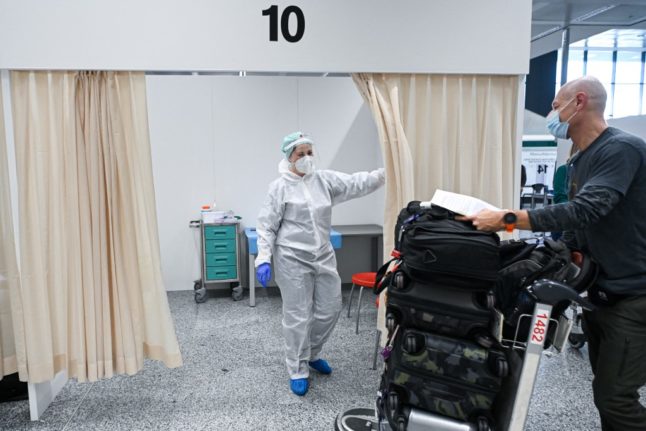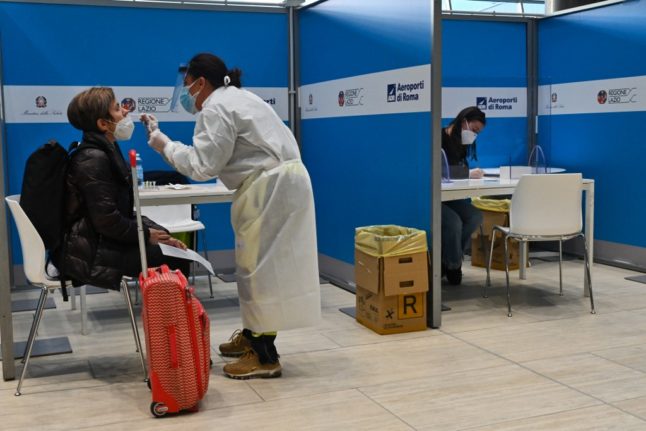The Italian government on Wednesday announced mandatory coronavirus testing “for all passengers from China and in transit through Italy”, making Italy the first – and so far only – European country to bring in such a measure.
The move came after China scrapped quarantine rules for inbound travellers from January 8th onwards, dismantling the last remaining piece of its stringent zero-Covid policy and ending some of the world’s harshest Covid border restrictions.
READ ALSO: Italy orders Covid screening for all arrivals from China
As travellers booked long-awaited flights to and from China this week, some countries reacted nervously to the news as health experts suggested an uncontrolled surge in cases in China could lead to the emergence of new Covid variants.
Italian Health Minister Orazio Schillaci said on Wednesday that the screening requirement was “essential to ensure the surveillance and identification of any variants of the virus in order to protect the Italian population”.
Experts from Rome’s Spallanzani hospital for infectious diseases said in a statement on Wednesday that the concern “is that, in a country [like China] with a high percentage of unvaccinated people, in which ineffective vaccines have been used that give low population protection, such a strong exponential growth in infections could generate the selection of a new variant, much more immune-evasive and transmissible”.

Spallanzani called for “international cohesion” on monitoring infections among passengers travelling from China, and Italian politicians are pushing for screening requirements to be brought in across the European Union.
Some within Italy are sceptical about the usefulness of the country’s testing requirement.
Italian newspaper Corriere della Sera on Wednesday wrote that testing passengers arriving on direct flights from China “risks not identifying most of the people who arrive [in Italy from China],” because, Corriere estimated, “only five percent of travellers departing from China arrive in Italy via a direct air connection.”
According to flight data and statements from border officials, Corriere said, most passengers arriving in Italy from China transferred at Brussels, Paris, Frankfurt, or Helsinki airports.
Italy was the first country in Europe to announce mandatory testing for air passengers arriving from China, with the requirement effective immediately.
The US announced later on Wednesday that from January 5th travellers from China will be required to take a Covid test within the two days before travel and provide a negative test result before boarding their flight.
The US Centers for Disease Control and Prevention said the move was due to the surge in infections and a lack of adequate and transparent information from China, particularly on the strains circulating in the country.
Japan, India, South Korea and Taiwan are also requiring tests for visitors from China, while Malaysia announced new tracking and surveillance measures.
But Italy appears to be taking a much more cautious line than neighbouring countries.
At the time of publishing no other EU member states have said that they will follow suit, although French President Emmanuel Macron has asked his government to take “protective measures”.
“From a scientific point of view, there is no reason to bring back controls at the border … but that could change any day,” Reuters quoted Brigitte Autran, head of the French health risk assessment committee COVARS, as saying on Thursday.
The UK government also said it currently had “no plans” to introduce mandatory testing for arrivals from China.
Germany’s government on Wednesday said it saw no need to impose new travel restrictions, and Austria stressed the economic benefits of the return of Chinese tourists to Europe.
In Italy, however, Deputy Prime Minister and Transport Minister Matteo Salvini said in a Twitter post that “Italy cannot be the only country to carry out anti-Covid checks at airports for those arriving from China.”
“I have asked that checks and possible limitations be applied throughout Europe.”
Health officials from the European Union’s 27 countries will meet later on Thursday to discuss how to coordinate the European response to China’s Covid surge.



 Please whitelist us to continue reading.
Please whitelist us to continue reading.
Member comments